April 8, 2024
A new scarf! And a stunning one…
One certainly could include the vivid red and gold in a color palette too, if one was inclined… but I’m going to focus on the beautiful blue:
Today’s heroine is quite committed to wearing black and white, and ONLY black and white. It’s her thing, and it makes it possible for her to buy the very nicest clothes she can afford.
Also, it opens the door for her to own all kinds of accessory families, in all kinds of colors. Imagine gold, silver, bright red, soft pink…
So she’s planning outfits for a summer trip around her new and cherished scarf – they look like this:
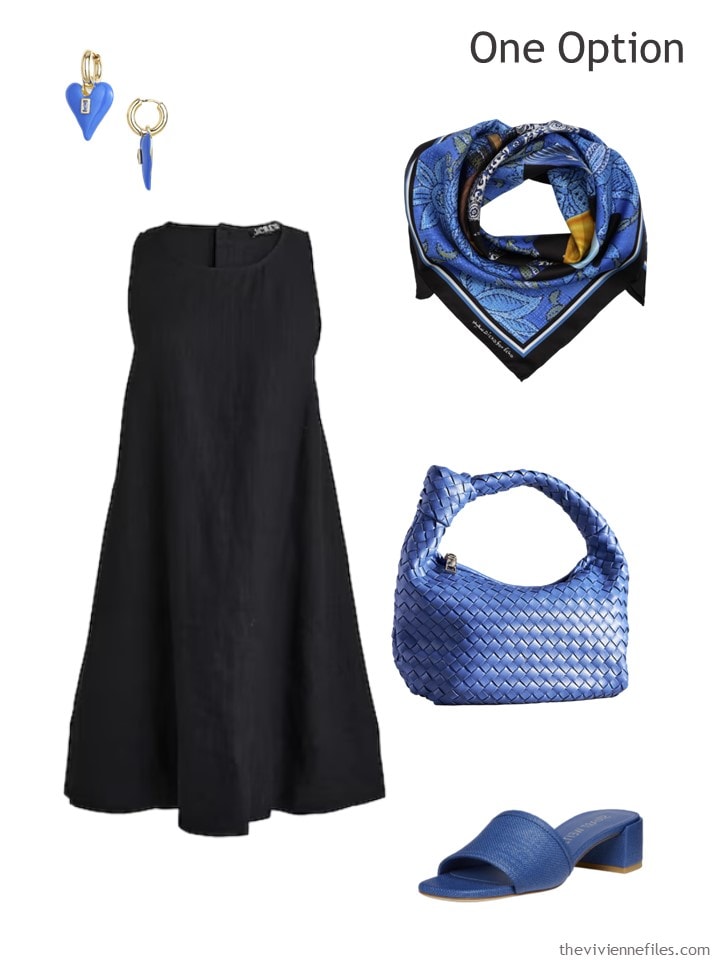
Earrings – Nakamol; linen dress – J.Crew; scarf – Echo; bag – Melie Bianco; sandals – Stuart Weitzman
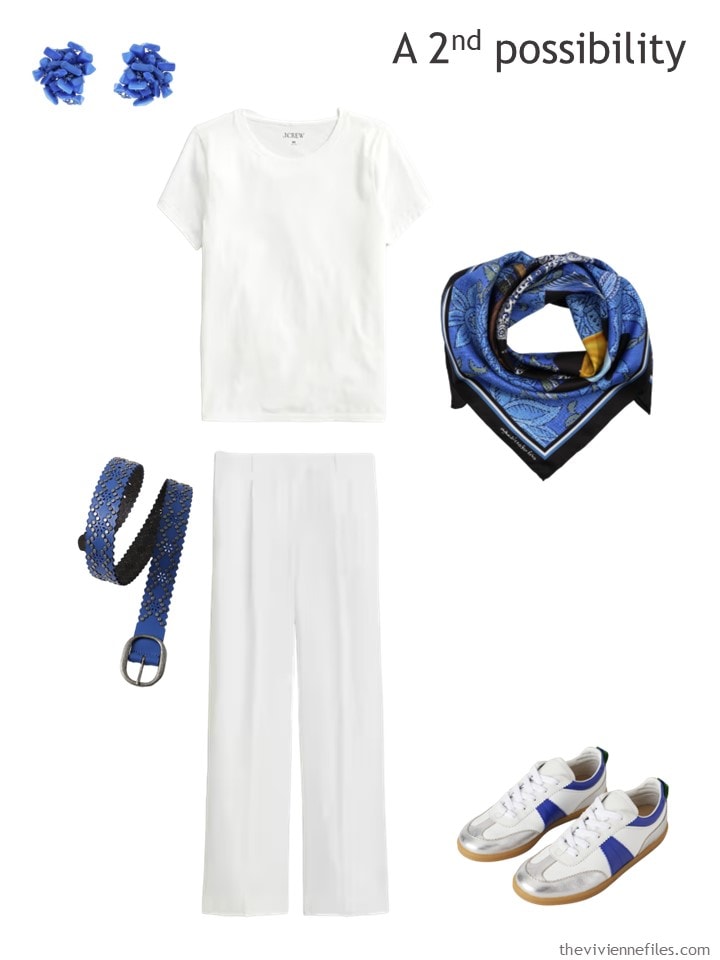
earrings – Lavish by Tricia Milaneze; white tee shirt – J.Crew; scarf – Echo; belt – Free People; white linen pants – J.Crew; sneakers – Boden
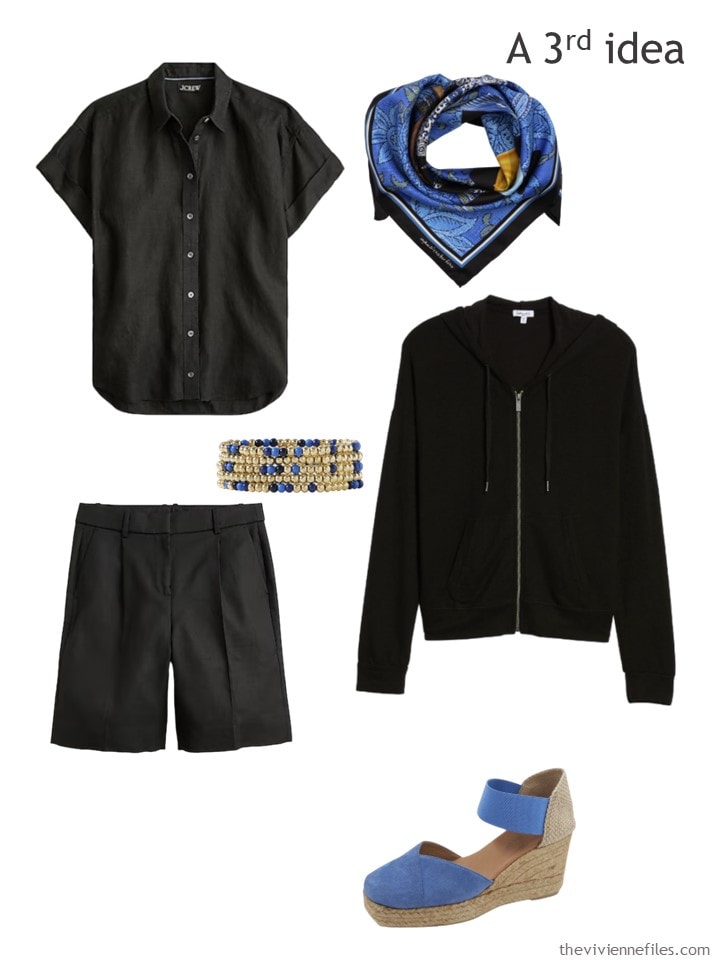
Camp shirt – J.Crew; scarf – Echo; bracelet – Roxanne Assoulin; shorts – J.Crew; hooded sweatshirt – Splendid; espadrilles – Andre Assous
I suspect this might be her travel outfit…
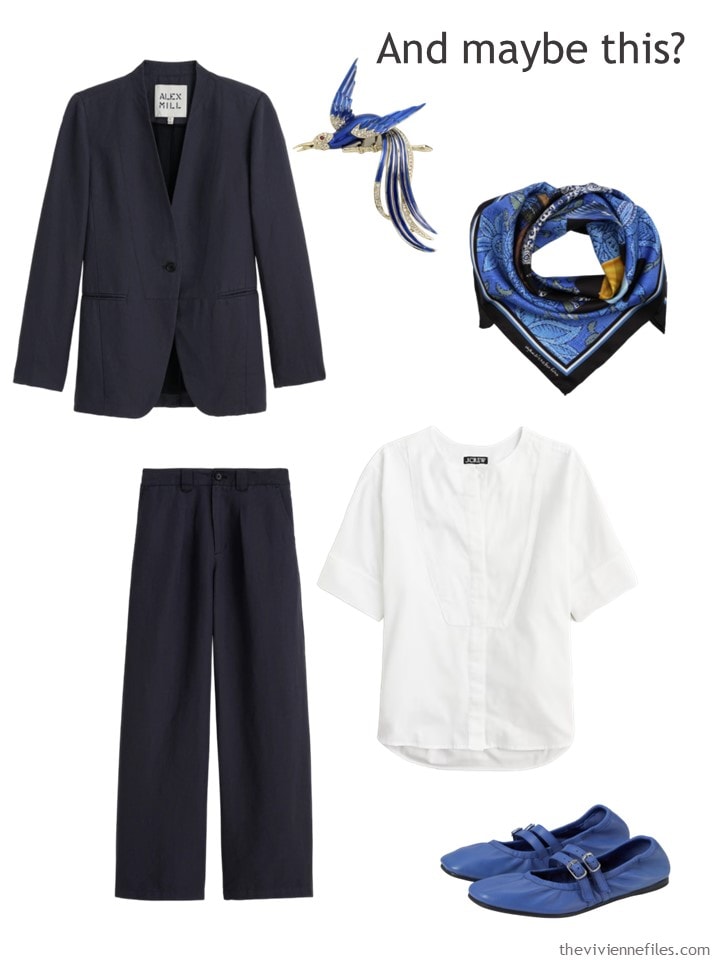
Blazer – Alex Mill; brooch – The Met Store; scarf – Echo; pants – Alex Mill; white bibbed top – J.Crew; flats – Free People
So all of her chosen items, assembled, look like the following. I think it’s an interesting approach…
So what else can one do with these nine garments? I thought of four other combinations:
Of course, any heroine could do something similar with any neutrals and any accent color… I’m going to visit the most recent Pantone New York and London “new colors” in the next few posts, so it’s a timely idea!
love,
Janice
p.s. Ten years ago, I was busy with caretaking responsibilities (I do this a lot!), but I shared with you “Ten Minimalist Icons” as chosen by the authors of one of my favorite books – Ma To-Do List by Jeanne-Aurore Colleuille and Laure Gontier.
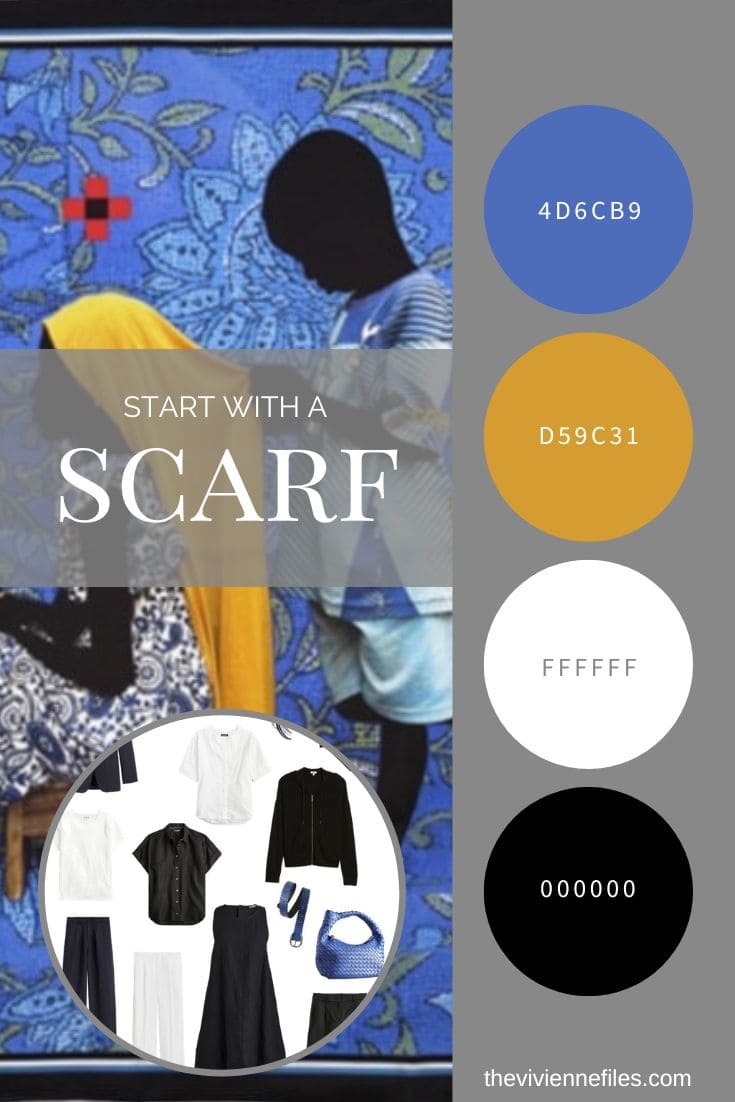
Like this wardrobe? Save it to Pinterest!
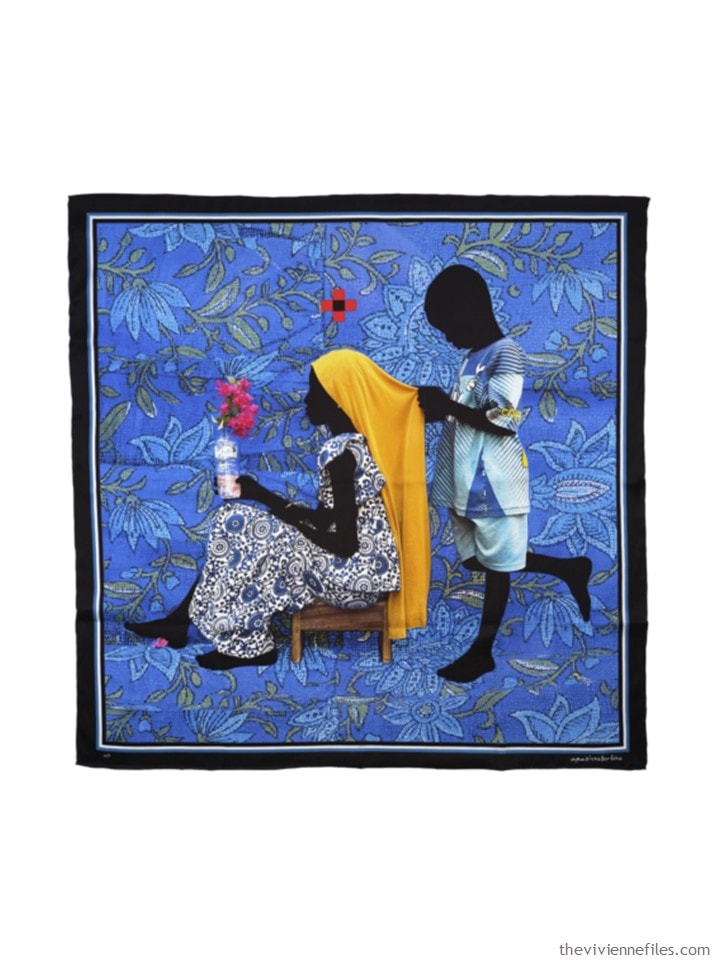
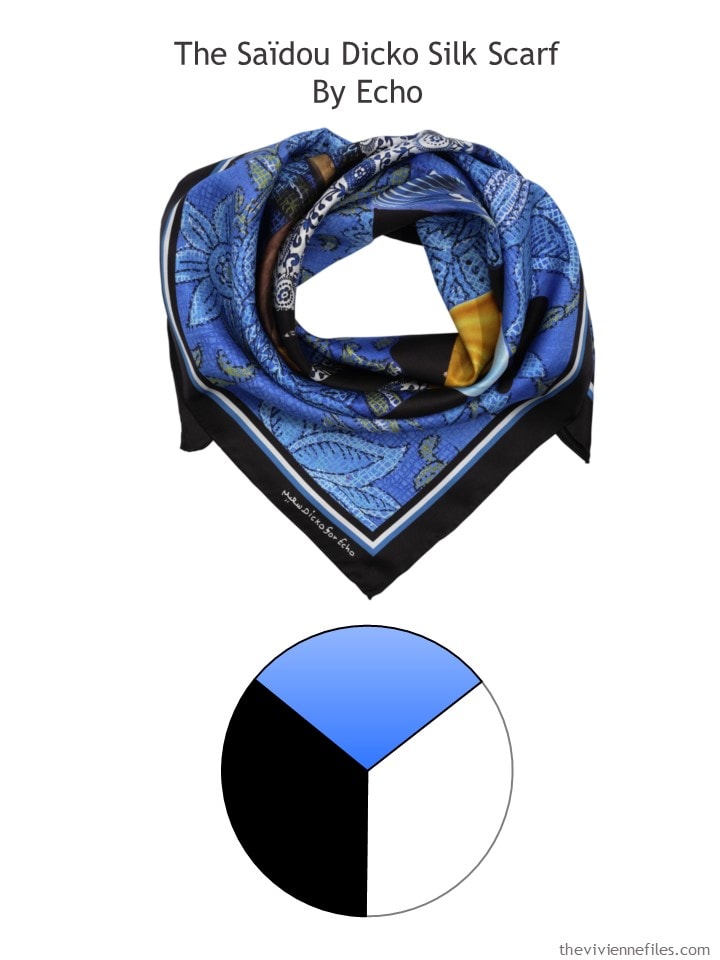
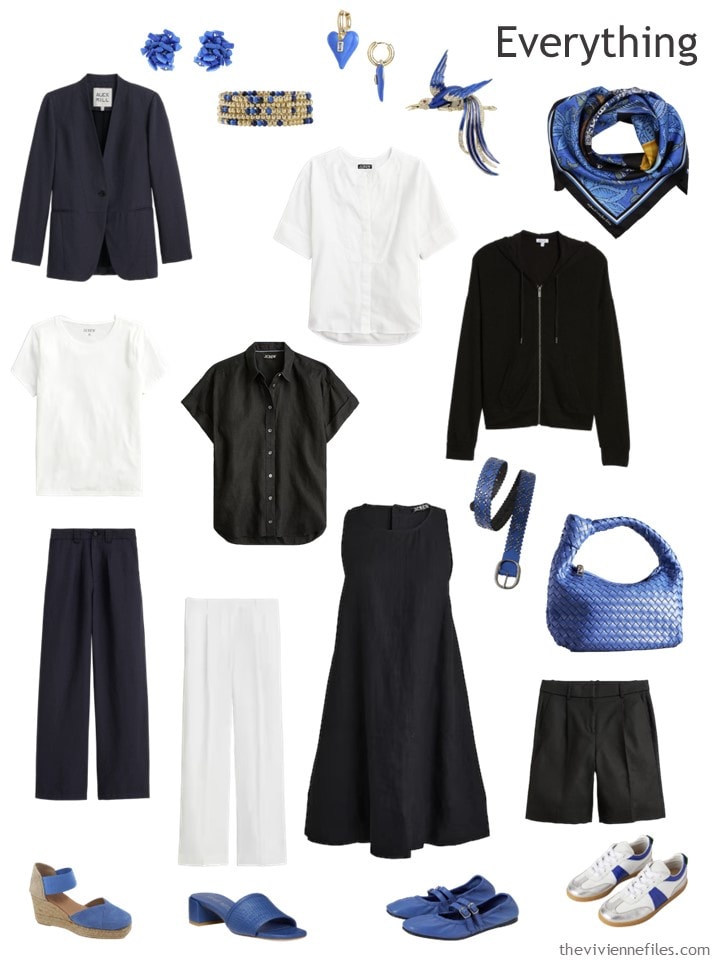
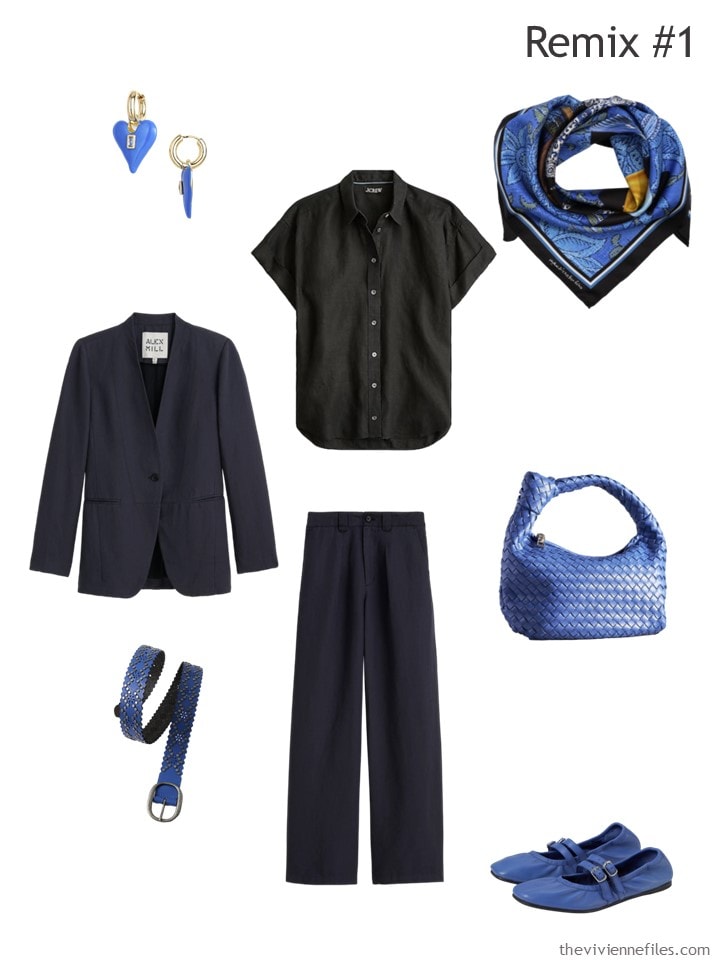
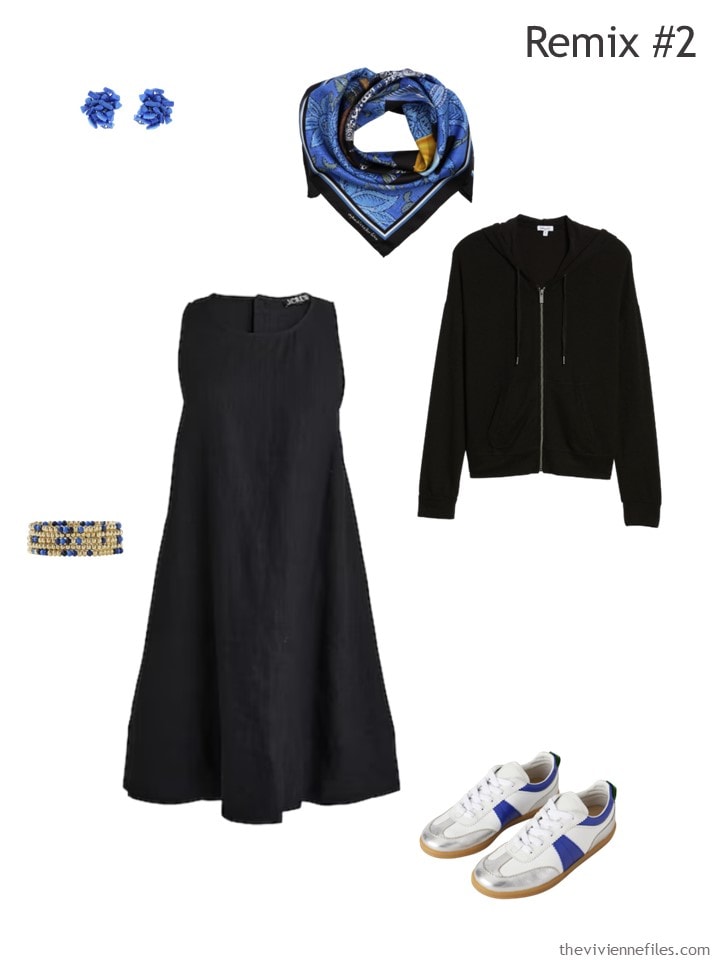
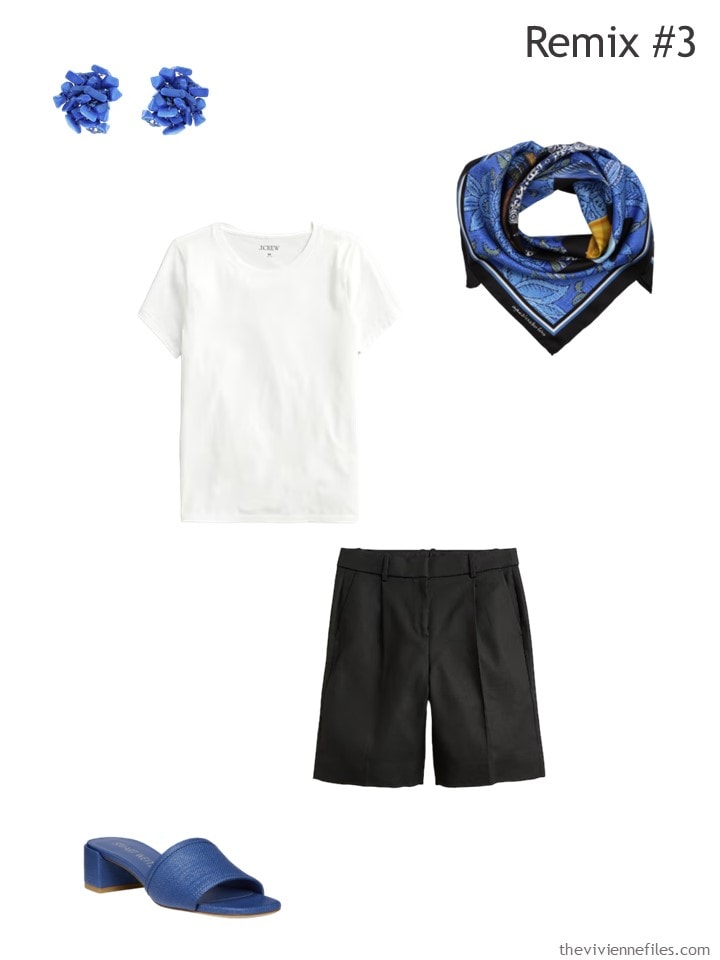
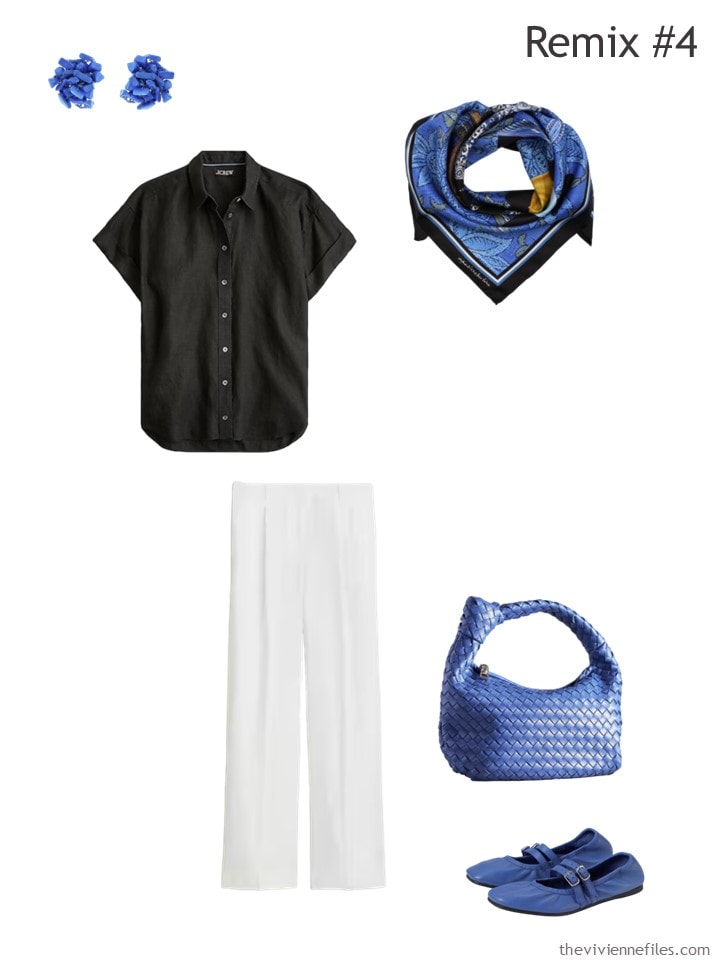
Just…Wow! Stunning combinations.
Gorgeous scarf and beautiful wardrobe! I really like this idea of sticking to 2 neutrals (mine are navy and off-white) and then just adding accent colors in accessories. My accent colors would be purple, green, and pink. Plus denim. I’ll have to really think about doing this!
That scarf is so striking.
I haven’t looked to see what the latest Pantone colors are, but I’ve noted in stores and online, that dusty rose is coming back with a vengeance. 😱😱😱 The eighties are calling.
So I wish I wish I wish I could manage something like this. It’s lovely. And I can easily see why it would be so easy and versatile. That being said, navy is my only core neutral that I have in bottoms, tops, jackets, etc…. After wearing navy with accents for months I went for an explosion of color for spring/summer which includes a lavender/purple pair of pants and also a royal/cobalt blue pair of pants. I can wear them with my shades of blue and lavender I already have in my closet, so that’s a good thing. I did purchase a couple of toppers since all I had were navy. It’s not really warm enough here yet for spring weight clothing, but I’ve worn some of them in layers and it’s made me so happy. Looking forward to Pantone postings – it’s always so interesting. Not to mention the differences between New York and London colors which always makes me wonder – why?
This would work perfectly with navy! Navy on its own, navy and white, navy and beige, navy and olive, navy and red, navy and burgundy… Navy is maybe the most versatile neutral…
hugs,
Janice
Janice, thank you for all the “10 years ago” look-backs recently. Ten years ago I was in the middle of moving 2/3 of the way across the country (US) and worrying about my mother’s health. I missed many of these posts. It’s interesting to read them now. Sad to see Caroline Bessette Kennedy, though.
Love this approach. The scarf is stunning as are all the accessories. Loved that our heroine did not have any black shoes! One could certainly do the same with all red, all pink or all gold and have a lovely rather large wardrobe. Great travel idea.
I love this scarf! I find the image so moving and the colors are pretty too!
The bold blue accent stands up well with the optic black and white items. It’s easy to imagine our heroine having beauty bundles in several of the classic “Winter” colors. If she adds any light color groupings (like a light pink), I think she’ll need to be very patient about buying ones that are icy rather than muted pastels, esp. for high contrast outfits with both the black and white in them. Of course, the capsule could be made less optic with certain types of patterns/prints and/or by adding some grey as a mid-range value between the black and white.
I agree that this technique could be done using different neutrals, but I think it’s hard to beat the simplicity of the black and white version. Someone (like me) could try it in, say, navy and grey or navy and olive + white tops, but given how notoriously difficult these colors can be to match, and the range of values the other neutrals have, it does just feel harder to build a small, workable 4 season wardrobe in every other combination compared to black and white. (I know that not literally every black piece and every white piece can be readily mixed-and-matched, but the number of variables in this case does seem smaller to me compared to any other combination.)
I believe black and white provides a more pure blank background for the accent colors to pop against than something like navy and grey, where you really need to consider the undertones of your neutral pieces as well as the accent color and how that all works together.
I also think that it is much easier to wear combinations of black and white on repeat and have that not be noticed than other neutrals. Black, white, and a pure grey (which in practice, most are not) are the only non-color neutrals, and I do think they register less than the others due to their lack of color and their ubiquity. (Which is more distinctive: white top + black pants or grey top + navy pants?) This is not important to everyone, but it’s something to consider. While one heroine might happily be known as The Woman in Navy and Olive, another one might not like that at all.
As a practical matter, buying “the very best one can afford” really only works if the heroine has the commitment, patience, and discipline to not start branching out too much in adding clothes in her accent colors as well as accessories. And of course the accessories cost money too so you can still spend a lot using this method. So it’s interesting to consider whether this “strictly limited neutral clothing + accent color accessory bundles” approach actually does better on a “very best one can afford” basis than other approaches. I suspect that regardless of one’s specific approach, making the “very best one can afford” thing work requires commitment, patience, and discipline plus a lot of planning, a willingness to be satisfied with a (by typical standards) much smaller wardrobe, a high tolerance for wearing items/outfits on repeat, a personal style that does not veer too far from classic pieces with a long style longevity, and a stable weight/size/lifestyle/etc. situation.
“The very best one can afford” is such a fascinating concept once you start to break it down. It’s such a cliche at this point that people often say/hear it and don’t think too much about what it means, but there’s actually a LOT to unpack.
Sally – what an interesting analysis!
Counterpoint to the color (although I do agree with most of what you’re saying) – your best shade dark + your best shade white (think: navy and cream instead of black and white) is likely to be just as versatile as black and white, while being more flattering to you. Although the need to be careful to get “good matches” is a fair one. And no, I dont think anyone would notice any more than they would if you wore black and white. Same for charcoal grey and your appropriate off-white. Olive, tan, and some more “colored neutrals” I think would be noticed more, just because they seem to be a bit more rare.
To the interesting point about “wear the best you can afford” – I think the original intent was more like this : assuming that price and quality are correlated and that the higher priced a garment is the {better quality fabric is used; better quality thread is used; higher quality stitching is performed; seams are matched; seam allowances are present, with the understanding that you may tailor the garment to suit your body perfectly; the more you spend on a garment the more likely you are to follow the cleaning instructions/be gentle with it}, buying the best you can afford for your clothes will be cheaper in the long run.
If I had the discipline to pull it off/ decided I was committed to style/color… I would apply this principle to my “core clothing” (I dont want to call it basic) – stuff with the highest wear … and buy cheaper accessories (not so cheap that they fall apart on one wear, but my assumption is i would rotate through those so each piece is worn/laundered/etc more infrequently and will last longer at a lower price point. there is of course, a threshold of quality). I dont think the “core style” has to be “classic” – they just have to be true-to-you. I love bootcut jeans/ trouserleg pants – they make my body look balanced, legs look fabulous, and I feel pretty/powerful/good in them. I don’t care if they are “on-trend” or not, they will always be in my closet. Maybe I get a pair of fabulous ankle pants (for cheaper!) because they are “on-trend” and work with my shape, but it may not be something I “buy the best I can afford” for. If you are committed to boho skirts – same thing. And I think this is really where you can find people “who have found their style” and who are “keeping up with what is in style”. No disrespect meant to anyone at either end of the spectrum.
Unfortunately, I’m not so sure that the base assumptions, listed in { } above, really hold true anymore.
Thanks for prompting the thoughts :)
I read an article once about a woman executive who had only a black suit and jewel tone blouses. She had five of the suits (tailored, and they looked great on her), and wore one every day so that they got the same amount of wear, and a different blouse. They were expensive suits and blouses. She said it was great—she didn’t mind wearing the same thing every day, knew she always looked great, and never had to worry about what to wear. It was only her work wardrobe, but it’s a lot like the “very best one can afford” idea for the workday anyway.